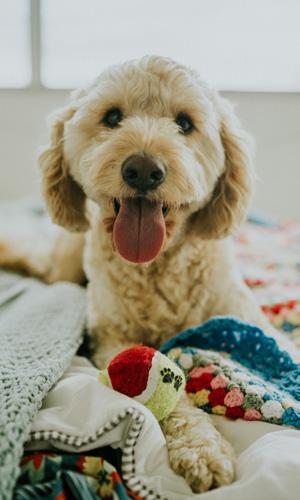
3 minute read
Pet separation anxiety tips
If you have been spending extra time with pooch during lockdown or have simply added a four-legged member to the clan, new dog mum Cara Wagstaff shares top tips to help you and your family adjust to life together and apart from your furry friend.
What is it? Pet separation anxiety is defined as a condition where your pet becomes extremely stressed when it is separated from a person it is attached to.
Advertisement
02

01 © Shutterstock/Alena Ozerova 02 © Unsplash Sebastien Lavalaye 03 © Unsplash/Jay Wennington 04 © Unsplash/Jamie Street
Signs and symptoms
Whining, barking and/or howling Urinating inside when they’re toilet trained Chewing, digging and/or scratching things they’re not meant to Drooling, panting or excessive salivation
Pacing Trying to escape
Ok. So now we know what to look for, what can you do to prevent this behaviour? The goal is to teach your pooch to be calm and relaxed when you’re not there, and this is done through managing your interactions with them. This includes changing your leaving and returning routine, reducing stressors associated with your departure and building up their own confidence.
03

Make it fun A tired, happy dog will be less stressed when you leave so – if possible – play or exercise with your pup before you go out. Go for a long walk, visit the park or use puzzles and enrichment activities to help exercise your dog’s mind as well as its body.
Give them a toy that they can play with while you’re gone. Try peanut butter in a kong, treats inside an empty egg carton or whatever you can think of, as long as it is safe for your dog to use without supervision. Once you return, remove this toy so your dog only has access to it (and its yummy treats) when you’re not home.
Normalise coming and going
Practice leaving your furry friend alone multiple times throughout the day by going to different rooms. Whether it’s for 30 seconds or three minutes, each session will help build up their confidence that you are
Preparation is key coming back. Pretend to leave Normalise and remove stress signals your pup associates with your departure, such as putting on a coat, shoes or picking up keys. Instead, spend time each day putting on your shoes and simply sitting down or picking up your keys and walking to another room.
Reward good behaviour When your dog does something good, for example not jumping on you when you return, give them a treat to show them that this is the preferred behaviour.

Leave something smelly An old sock, a towel or a piece of clothing... it can be anything you like. Dogs have a heightened sense of smell, so leaving your scent behind will help keep them relaxed.
Keep it calm Before leaving and when you return, ignore your pup for some time. When arriving home, encourage all family members to be quiet and use soft voices, only greeting the dog when it is also calm. Ask for help Know you’re going to be gone for a while? Ask a neighbour, friend or family member to check in on your pup or take them for a walk, or check out your local dog walkers and doggy daycare providers.
Please note :
If your dog’s symptoms are more extreme, we suggest contacting your local vet.









